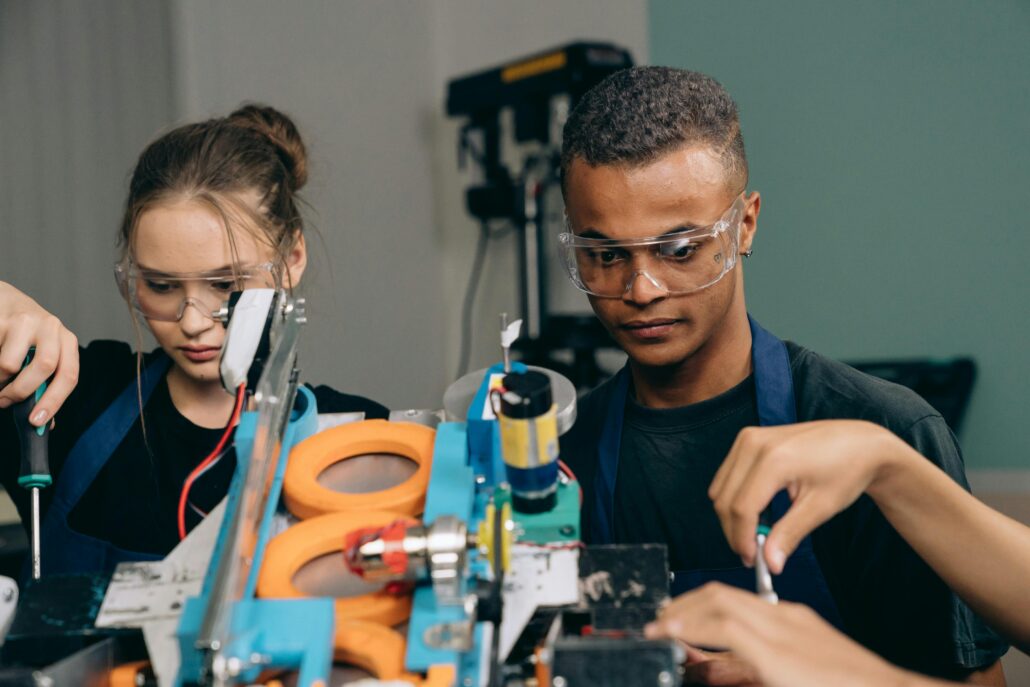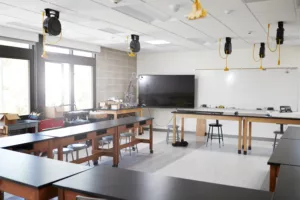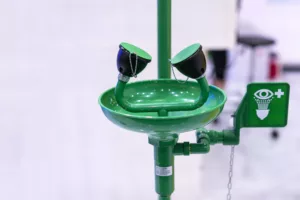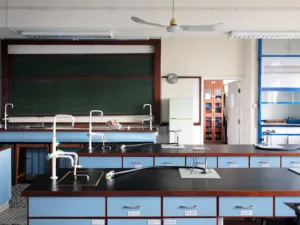By: Tyler S. Love, Ph.D. and Ken Roy, Ph.D.
In April of 2020 the T&E Education – Facilities and Safety Survey (TEE-FASS) was sent out to ITEEA members to collect responses about a myriad of safety topics related to K-12 Technology and Engineering (T&E) education, Career and Technical Education (CTE), and makerspaces. This study revealed some important findings due to the limited amount of prior research in this area as discussed in another article published on this study (Love et al., 2021). There were 718 participants from 42 states who completed the survey, of which 42 participants were Wisconsin educators. This article will present a very brief overview of a few key findings from the study. To view the full results from Wisconsin and see how they compared to the national averages please visit https://sites.google.com/view/2020-te-safety-study/
Wisconsin Science Safety Results
Below are just a few of the key findings that emerged from the responses submitted by Wisconsin educators.
- Course preps – Wisconsinites reported higher numbers of course preps than the national average. Approximately 33% had four preps and 50% had five or more per semester.
- Course Foci – Wisconsin respondents had a higher emphasis on teaching traditional courses (woods, metals, construction) versus engineering focused courses.
- Class Size – Class sizes were slightly lower than the national average. (Only 14% said their average class size was above 25 students, and 51% said their largest class was above 25 students).
- Students with Disabilities – The percentage of SWD in a T&E class was similar to the national average. Approximately 43% of Wisconsinites reported that 16- 25% of students in their classes were diagnosed with a disability.
- Budget and Administrative Support – Only 38% believed they had a sufficient budget for safety expenses, much lower than the national average. However, the majority of Wisconsin teachers viewed their administration’s support as good (36%) or excellent (24%).
- Safety Training – Far less Wisconsin teachers reported receiving safety training in their graduate level course work (12% in teaching methods courses and 14% in technical course work). Only 57% reported receiving safety training in their undergraduate teaching methods course, and only 52% in their undergraduate technical Additionally, 62% of Wisconsinites never received safety training from their school district. One positive finding was more teachers received some form of safety training from their state association (WTEA) in comparison to teachers in other states.
- Facilities – Wisconsin had a higher percentage of hybrid T&E classroom/lab facilities (79%) and solely dedicated T&E labs (19%) than other states. Moreover, Wisconsin reported having a greater percentage of large square footage facilities (40% had a facility over 1,200 square feet). These findings could be connected to the greater focus on traditional courses that Wisconsin participants reported teaching.
- Soldering – Among those Wisconsin teachers who indicated their students conduct soldering activities, only 27% reported some form of ventilation is used while soldering.
- 3D Printing – Among those Wisconsin teachers who indicated they use 3D printers in their lab, approximately 77% said they do not use any form of ventilation while their 3D printer is operating.
- Student Requirements – One positive statistic from this study was that all Wisconsin teachers said they require students to wear ANSI/ISEA 1 D3 safety glasses with side shields when working with solid materials. However, not all teachers required students to always sign a safety acknowledgement form (83%), secure long hair (88%), and other important practices to work in the lab.
- Facility Safety Practices – Wisconsin mirrored the rest of the country in terms of critical safety engineering controls and practices that are needed in labs. For example, only 52% of teachers had safety zones on the floor around hazardous equipment and work areas, 76% had an eyewash within 10 second access, 69% had accessible master power shut off switches, 69% had lockable tool storage, 57% reported having sufficient project storage, and only 69% had a first aid kit among many other critical lab safety
- Equipment – There was a much higher percentage of teachers in Wisconsin who used table saws in their labs (88%). Among those teachers, a greater percentage had SawStop table saws (78%) in comparison to the national average (56%). Wisconsin teachers also allowed more student led operation of the table saw while the teacher was in the lab.
- Safety Incidents – Wisconsin teachers reported a higher rate of safety incidents per year (55% reported 1-10 incidents, 10% reported 11-20 incidents). Nationally, the main cause for these was hot glue guns, however in Wisconsin the most prevalent causes were student operated equipment/ machinery (38%), hand or portable power tools (31%), sharp materials or splinters/slivers (24%), and hot glue guns (24%).
- Minor Safety Accidents – Wisconsin had a higher occurrence of minor accidents in both one and five-year spans. Almost 70% of teachers reported 1-5 minor accidents within the past year while 14% had 6-10 minor accidents. Within a five- year span Wisconsin was 8% lower than the national average in the 1-10 minor accident occurrences category, but 14% higher in the 21-30 accident occurrences category. It was not investigated whether the focus of the courses played a role in these increased accident rates.
- Major Safety Accidents – Major accident rates were also higher over one and five-year spans in Wisconsin. The occurrence of 1-5 major accidents during a one-year span was 12% higher than the national average. Additionally, the occurrence of 1-10 major accidents over the past five years was 14% higher. Most of the minor and major accidents resulted in cuts or lacerations, and all occurred to fingers.
- Perceived factors for Unsafe Conditions – Wisconsinites had similar responses to the national population, citing the following as what they believed were the top three factors associated with unsafe conditions: 1) student failure to follow safety protocols, 2) overcrowding, and 3) percentage of students with disabilities in a class. The national population also cited classroom management and inadequate facilities as top factors.
In addition to calculating percentages, some statistical analyses were conducted using the responses from the national population of 718 teachers. These tests were conducted to examine if any factors served as significant predictors of incidents or accidents. From these analyses a number of factors were found to significantly contribute to or reduce the likelihood of accidents. Among those found to reduce the chance of accidents were factors such as having safety glasses for every student, having safety zones labeled near equipment/hazardous areas, having a SawStop table saw compared to another type, and many other factors. The full list of statistically significant factors can be found in Love et al. (2021).
Interestingly, the type of safety training received was found to be one the most significant predictors of accidents. Analyses revealed that different safety training opportunities completed as isolated experiences did not significantly reduce the chance of an accident occurring. However, when these opportunities were combined to create a more comprehensive training experience, the rate of accidents significantly decreased.
For example, teachers who received T&E safety training in an undergraduate or graduate teaching methods course, and safety training from their district upon initial hiring, and safety training updates within the past five years from either their district or an external source were 37% less likely to have had an accident occur within the past five years. This indicates that teacher preparation programs and school districts play an integral role in ensuring educators have the initial and continual safety training they need to reduce the chance of accidents.
Wisconsin Science Safety Recommendations
A number of recommendations resulted from this study. For example, there are a number of safety issues which need to be addressed to comply with federal, state, and local legal safety standards, and also align with better professional safety practices. One example is the requirement for students to always tie back long hair, secure loose clothing, and remove or secure loose jewelry when working in a lab setting. Another is the need for ventilation when using soldering and 3D printing equipment. Emerging studies have found many desktop 3D printers produce hazardous levels of ultrafine particles (UFPs) during operation, posing a risk not only for students, but more so for the instructor who is working in that area throughout the day.
From this study a number of other critical and very practical data driven safety recommendations were provided. They can be found in a recent National Science Teaching Association Safety Blog Commentary by Dr. Ken Roy (Roy, 2021), and in the report presenting the full Wisconsin article at https://sites.google.com/view/2020-te-safety-study/
Tyler S. Love, Ph.D. Assistant Professor of STEM Education Penn State University, Harrisburg.
Kenneth R. Roy, Ph.D. Director of Environmental Health & Safety, Glastonbury Public Schools (CT); Chief Science Safety Compliance Adviser/Chief Safety Blogger National Science Teaching Association (NSTA); Safety Compliance Officer National Science Education Leadership Association (NSELA).















